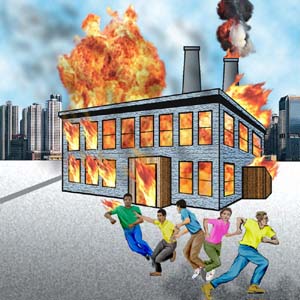Woodworking eTool
Production » Fire and Explosion
Woodworking facilities are inherently prone to fires and explosions, for the following reasons:
- They contain large quantities of fuel in the form of wood and wood products, sawdust, and flammable materials such as paints, oil finishes, adhesives, solvents, and liquid propane for internal combustion engines. Woodworking facilities are especially at risk for fire due to the abundant production of sawdust, which will ignite and burn far more easily than whole pieces of lumber. Sanders, routers, and shapers in particular produce large amounts of fine dust. Very fine wood dust is especially hazardous. It can accumulate on rafters and other building structural components and in unexpected spots all around your facility, far from the point of generation.
- They contain ignition sources, such as potentially faulty electrical wiring, cutting and welding operations, sparking tools, propellant actuated tools, and employee smoking. There is also the potential for static electrical discharges and lightning.
An annual inspection of the lockout/tagout program should be conducted to ensure that it is followed.

-
>> Fire and Explosion
Potential Hazards
Large quantities of fuel in the form of wood and wood products, sawdust, and flammable materials such as paints, oil finishes, adhesives, solvents, and liquid propane for internal combustion engines.
Possible Solutions
Preventing the buildup of dust is one of the key means for controlling fire and explosion hazards. The principal engineering control technology for control of dust is exhaust ventilation. The primary work practice control is good housekeeping.
Dust collection is best accomplished at the source-at the point of operation of the equipment, if feasible. For many pieces of equipment, well-designed ducts and vacuum hoods can collect most of the dust generated before it even reaches the operator. Very fine dust that manages to escape point-of-source collection can be captured from above by general exhaust points located along the ceiling. These control technologies are effective for most equipment, excepting machines that commonly produce the very finest dust or large quantities of dust.
Good housekeeping extends to periodic hand cleaning of your entire facility, as some dust will escape from even the best exhaust system and will eventually accumulate on rafters and other out-of-the- way spots. Also, it is extremely important to inspect and clean your exhaust ventilation system on a regular basis to maintain maximum efficiency.
You must also:
- Ensure the proper use and storage of flammable materials, such as paints, finishes, adhesives, and solvents.
- Segregate tasks particularly prone to fire and explosion hazards, such as spray painting, welding, and use of powder-actuated nail guns.
- Train employees to recognize, avoid, and correct potentially hazardous conditions and behaviors. Train employees so that they are acquainted with the special equipment and aspects of building design related to dealing with fires and explosions.
- Control ignition sources. This involves using electrical systems rated for the projected use and protected by appropriate circuit breakers, grounding all equipment prone to accumulating static electrical charges, grounding entire buildings against the possibility of lightning strikes, and controlling and banning smoking in and around the workplace. Consult Subpart S of OSHA's General Industry Standards for more information on electrical design requirements.
- Never permit blow-down of accumulated dust with compressed air. Blowing dust with compressed air will create the very type of dust cloud that presents the greatest explosion hazard.
- Provide continuous local exhaust ventilation on all woodworking machines. The local exhaust systems must have a suitable collector. Dust collection systems must be located outside the building, unless the exceptions described in NFPA standards are met.
- Segregate combustible and flammable materials such as lumber stock and chemical solvents from each other and from ignition sources.
- Ensure that you use equipment with a hazard classification appropriately rated for your work environment.
What Other Fire Protection Measures Should Be Taken?
- Fire-resistant construction and/or fire-resistant materials (particularly fire doors that could be used to contain the spread of a fire).
- Explosion relief devices, such as blow-out panels in walls, floors, and ceilings that protect structural integrity in the event of an explosion.
- Multiple emergency exits that are well marked and easily accessible. These exits should lead people directly away from the areas of greatest likely hazard.
- Emergency alarms and communications systems to promote rapid evacuation and fire fighting response.
- Automatic sprinkler systems designed for a worst-case fire scenario.
- Readily accessible, portable fire extinguishers fully charged with fire retardants appropriate to the types of fires likely to occur in that area.
What Should You Do to Protect Workers in the Event of a Fire?
- Install an alarm system to warn for necessary action or safe escape [29 CFR 1910.165].
- Establish emergency plans and fire prevention plans [29 CFR 1910.38].
- Install battery-operated emergency lighting along the floor to aid in the evacuation of smoke- filled buildings.
- Store fire-retardant blankets, clothing, and masks in areas where workers could conceivably need them to pass through smoke and flames to reach exits.
- Maintain first-aid kits designed for the initial treatment of burns and smoke inhalation. These kits should be stored outside the area of fire risk.

